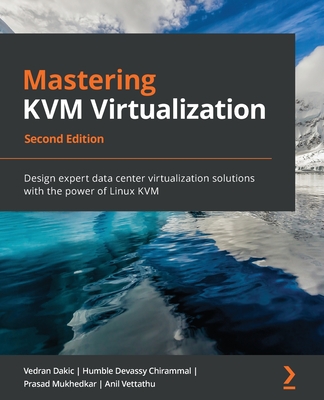KVM Virtualization Cookbook
暫譯: KVM 虛擬化食譜
Konstantin Ivanov
- 出版商: Packt Publishing
- 出版日期: 2017-06-20
- 售價: $2,420
- 貴賓價: 9.5 折 $2,299
- 語言: 英文
- 頁數: 340
- 裝訂: Paperback
- ISBN: 178829467X
- ISBN-13: 9781788294676
-
相關分類:
Linux
-
其他版本:
Mastering KVM Virtualization - Second Edition
買這商品的人也買了...
-
 3D 視覺專題製作:Kinect、Processing、Arduino 及 MakerBot (Making Things See: 3D vision with Kinect, Processing, Arduino, and MakerBot)
3D 視覺專題製作:Kinect、Processing、Arduino 及 MakerBot (Making Things See: 3D vision with Kinect, Processing, Arduino, and MakerBot)$680$537 -
 $352深入淺出 DPDK
$352深入淺出 DPDK -
 VR 虛擬實境學習手冊|為桌面應用、網頁、行動裝置打造身臨其境的體驗 (Learning Virtual Reality: Developing Immersive Experiences and Applications for Desktop, Web, and Mobile)
VR 虛擬實境學習手冊|為桌面應用、網頁、行動裝置打造身臨其境的體驗 (Learning Virtual Reality: Developing Immersive Experiences and Applications for Desktop, Web, and Mobile)$420$332 -
 當虛擬實境 VR 為分子,3D 視訊處理為分母,未來無限
當虛擬實境 VR 為分子,3D 視訊處理為分母,未來無限$520$442 -
 人氣遊戲這樣做! Unity3D 遊戲設計實例講堂, 2/e
人氣遊戲這樣做! Unity3D 遊戲設計實例講堂, 2/e$620$527 -
 $403Ceph Cookbook (簡體中文版)
$403Ceph Cookbook (簡體中文版) -
 Design of Analog CMOS Integrated Circuits, 2/e (IE-Paperback)
Design of Analog CMOS Integrated Circuits, 2/e (IE-Paperback)$1,600$1,568 -
 $301Unity虛擬現實開發實戰
$301Unity虛擬現實開發實戰 -
 $403Unity 3D 實戰核心技術詳解
$403Unity 3D 實戰核心技術詳解 -
 $1,568Python Network Programming Cookbook Second Edition
$1,568Python Network Programming Cookbook Second Edition -
 演算法圖鑑:26種演算法 + 7種資料結構,人工智慧、數據分析、邏輯思考的原理和應用 step by step 全圖解
演算法圖鑑:26種演算法 + 7種資料結構,人工智慧、數據分析、邏輯思考的原理和應用 step by step 全圖解$450$356 -
 Design of CMOS Phase-Locked Loops: From Circuit Level to Architecture Level (Hardcover)
Design of CMOS Phase-Locked Loops: From Circuit Level to Architecture Level (Hardcover)$1,960$1,921 -
 演算法精鑰 (推薦:李家同‧唐傳義‧徐道中‧黃永輝)
演算法精鑰 (推薦:李家同‧唐傳義‧徐道中‧黃永輝)$580$568 -
 Mastering Ubuntu Server - Fourth Edition: Explore the versatile, powerful Linux Server distribution Ubuntu 22.04 with this comprehensive guide
Mastering Ubuntu Server - Fourth Edition: Explore the versatile, powerful Linux Server distribution Ubuntu 22.04 with this comprehensive guide$2,100$1,995
相關主題
商品描述
Key Features
- Build, manage and scale virtual machines with practical step-by-step examples
- Leverage the libvirt user-space tools and libraries to manage the life-cycle of KVM instances
- Deploy and scale applications inside KVM virtual machines with OpenStack
Book Description
Virtualization technologies such as KVM allow for better control over the available server resources, by deploying multiple virtual instances on the same physical host, or clusters of compute resources. With KVM it is possible to run various workloads in isolation with the hypervisor layer providing better tenant isolation and higher degree of security.
This book will provide a deep dive into deploying KVM virtual machines using qemu and libvirt and will demonstrate practical examples on how to run, scale, monitor, migrate and backup such instances. You will also discover real production ready recipes on deploying KVM instances with OpenStack and how to programatically manage the life cycle of KVM virtual machines using Python. You will learn numerous tips and techniques which will help you deploy & plan the KVM infrastructure. Next, you will be introduced to the working of libvirt libraries and the iPython development environment.
Finally, you will be able to tune your Linux kernel for high throughput and better performance. By the end of this book, you will gain all the knowledge needed to be an expert in working with the KVM virtualization infrastructure.
What you will learn
- Deploy different workloads in isolation with KVM virtualization and better utilize the available compute resources
- Explore the benefits of running applications with KVM and learn to prevent the "bad-neighbor" effect
- Leveraging various networking technologies in the context of virtualization with Open vSwitch and the Linux bridge.
- Create KVM instances using Python and inspect running KVM instances
- Understand Kernel Tuning for enhanced KVM performance and better memory utilization
About the Author
Konstantin Ivanov is a Linux systems engineer, an open source developer, and a technology blogger who has been designing, configuring, deploying, and administering large-scale, highly available Linux environments for more than 15 years.
His interests include large distributed systems and task automation, along with solving technical challenges involving multiple technology stacks.
Konstantin received two master of science in computer science degrees from universities in Bulgaria and the United States, specializing in system and network security and software engineering.
In his spare time, he loves writing technology blogs and spending time with his two boys.
Table of Contents
- Getting Started with QEMU and KVM
- Using libvirt to Manage KVM
- KVM Networking with libvirt
- Migrating KVM Instances
- Monitoring and Backup of KVM Virtual Machines
- Deploying KVM Instances with OpenStack
- Using Python to Build and Manage KVM Instances
- Kernel Tuning for KVM Performance
商品描述(中文翻譯)
主要特點
- 透過實用的逐步範例來建立、管理和擴展虛擬機器
- 利用 libvirt 使用者空間工具和函式庫來管理 KVM 實例的生命週期
- 使用 OpenStack 在 KVM 虛擬機器內部部署和擴展應用程式
書籍描述
虛擬化技術如 KVM 允許更好地控制可用的伺服器資源,通過在同一物理主機或計算資源集群上部署多個虛擬實例。使用 KVM,可以在隔離的環境中運行各種工作負載,並且虛擬機監控層提供更好的租戶隔離和更高的安全性。
本書將深入探討如何使用 qemu 和 libvirt 部署 KVM 虛擬機器,並展示如何運行、擴展、監控、遷移和備份這些實例的實用範例。您還將發現使用 OpenStack 部署 KVM 實例的實際生產準備食譜,以及如何使用 Python 程式化地管理 KVM 虛擬機器的生命週期。您將學習許多技巧和技術,幫助您部署和規劃 KVM 基礎架構。接下來,您將了解 libvirt 函式庫的運作及 iPython 開發環境。
最後,您將能夠調整您的 Linux 核心以實現高吞吐量和更好的性能。在本書結束時,您將獲得成為 KVM 虛擬化基礎架構專家的所有知識。
您將學到什麼
- 在 KVM 虛擬化中隔離部署不同的工作負載,並更好地利用可用的計算資源
- 探索使用 KVM 運行應用程式的好處,並學習如何防止「壞鄰居」效應
- 在虛擬化的背景下利用各種網路技術,如 Open vSwitch 和 Linux bridge。
- 使用 Python 創建 KVM 實例並檢查正在運行的 KVM 實例
- 了解內核調整以增強 KVM 性能和更好的記憶體利用率
關於作者
Konstantin Ivanov 是一位 Linux 系統工程師、開源開發者和技術部落客,擁有超過 15 年設計、配置、部署和管理大規模、高可用性 Linux 環境的經驗。
他的興趣包括大型分散式系統和任務自動化,以及解決涉及多個技術堆疊的技術挑戰。
Konstantin 獲得了來自保加利亞和美國的兩個計算機科學碩士學位,專攻系統和網路安全及軟體工程。
在空閒時間,他喜歡撰寫技術部落格並與他的兩個兒子共度時光。
目錄
- 開始使用 QEMU 和 KVM
- 使用 libvirt 管理 KVM
- KVM 網路與 libvirt
- 遷移 KVM 實例
- KVM 虛擬機器的監控與備份
- 使用 OpenStack 部署 KVM 實例
- 使用 Python 建立和管理 KVM 實例
- KVM 性能的內核調整











